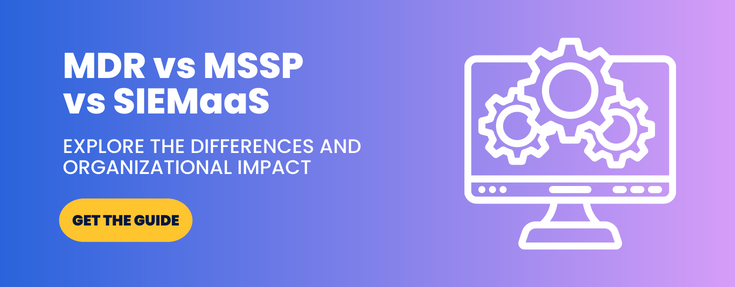Managed Services vs SaaS: What's the Difference?

 By
Jason Miller
·
4 minute read
By
Jason Miller
·
4 minute read
Not that long ago, if an organization needed software they would call the software provider, get them to deliver a bunch of CDs and license keys, load the product on their systems and then start using it. But with the advent of the cloud and continually evolving business models, much has changed. And let’s be honest, it’s sometimes confusing. Nowhere is this confusion more apparent than in the realm of the difference between managed services and Software-as-a-Service (SaaS).

What is Software as a Service and why do businesses love it?
Software as a service (SaaS) is a cloud computing model where software applications are delivered over the internet on a subscription basis. This allows users to access and use the software without having to install or maintain it on their own devices or servers.
If your business has ever used any product through the cloud, then it has used SaaS. Take Gmail, for instance. The search giant’s email service is, technically, SaaS because it’s software that’s distributed through the cloud: you can access your Gmail account on any internet-connected device at any location.
In general, SaaS refers to services delivered through the cloud that your company pays for. Office 365 from Microsoft, for instance, is SaaS, because the company provides it through the cloud and charges firms a subscription fee for the privilege of using it, depending on the number of users.
Top benefits of a SaaS model:
.jpg?width=1920&height=1080&name=Four%20reasons%20to%20implement%20a%20SaaS%20Model%20(1).jpg)
- Reduced Time To Implementation. It can take a long time to install a new software update on a legacy system. But with SaaS, you can start using a service immediately through the cloud: there’s often no delay at all.
- Lower Costs. When installing software on legacy systems, firms not only have to pay for the software itself but the time and expense of installing it. Cloud-based solutions avoid all of this, leading to lower costs overall.
- Scalability. Cloud-based services can scale as a business scales. The cost of purchasing ten licenses for Office 365, for instance, is much lower than buying one hundred.
- Easy To Use. The app-like nature of most SaaS solutions means that you don’t have to invest so much time and money training staff to use features effectively. Many services are highly intuitive and self-explanatory.
Managed Services vs SaaS
Managed services are different. Managed services is the practice of outsourcing the management and maintenance of a company's IT infrastructure and services to a third-party provider.
Take SIEM software, for instance. SIEM software might be a SaaS if the developer provides it through the cloud, but it doesn’t qualify as a managed service until another third-party company takes over things like monitoring from in-house IT staff. A fully-managed security solution, like BitLyft’s partnership with Securonix, would not only provide a firm with SIEM software but also have a dedicated SOC with trained analysts processing security logs and events.
Customer relationship management tools also provide an excellent example of the difference between SaaS and managed services. A company like Salesforce offers CRM as SaaS. Salesforce allows companies to access their CRM facilities through cloud portals, charging them a fee depending on the number of users (for instance, the number of customer reps at a real estate agency). Salesforce’s CRM services only become managed services when clients outsource tasks like communicating with customers or analyzing CRM data to Salesforce itself. Suddenly, SaaS turns into a managed service which takes over the human component.
Managed services can also go further than managing software and help businesses on the hardware side too. Suppose, for instance, that a firm outsources the task of maintaining security on its IT network to a third-party firm. That third-party firm might do things like event reporting and threat detection, but it could also offer firms support to upgrade and improve their hardware. A managed security company, for instance, could recommend that a firm switch out its ailing servers and replace them with services rendered through the cloud. Managed services, therefore, are more comprehensive than SaaS, and can spur the transformation of the overall company IT strategy.
What are the benefits of Managed Services?
One of the reasons companies love SaaS is that it offers a low-cost alternative to traditional, in-house solutions. It gives them the flexibility they need to scale up, scale down, and implement new products, without having to go through costly processes.
Managed services, on the other hand, are more expensive, but they offer far more comprehensive solutions. Not only do they offer the benefits of SaaS, but they can also help a company with maintenance, upgrades, and integration of software to create better workflows.
Managed services, however, go beyond merely enabling companies to make better use of the software they already have: they also provide additional services that firms can’t get through SaaS, no matter how feature-packed.
In the realm of security, for instance, firms can use managed security services to identify un-utilized digital assets and bring them into the security framework. Company data inevitably becomes fragmented over time, and some data can be lost or forgotten. Managed services can bring all of the data under a single security dashboard, providing protection, while adding value at the same time. This goes well beyond the capabilities of traditional security software.
Managed services can help with integration too. Left to its own devices, one piece of software delivered over the cloud won’t talk to another: they’re just not that sophisticated. But a managed service can identify opportunities to integrate software and improve company processes. Suppose, for instance, that a company uses two pieces of cloud-delivered plugins for its website. One of those plugins is a tool that collects data from website forms, and the other is a website chat app. A managed service could link those two apps together, allowing sales reps to immediately talk to customers on the website using the chat box as soon as they fill in details on the form.
The solution you choose depends primarily on your needs. Some companies need basic software delivered over the cloud to perform the function that they want. In that case, SaaS is ideal. Others need help implementing software and integrating their systems, in which case, managed services are better.

